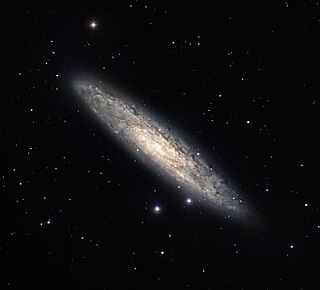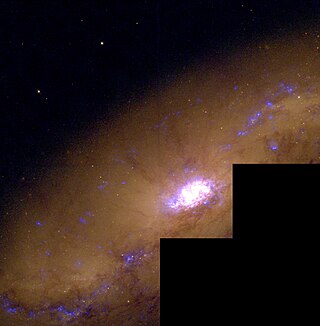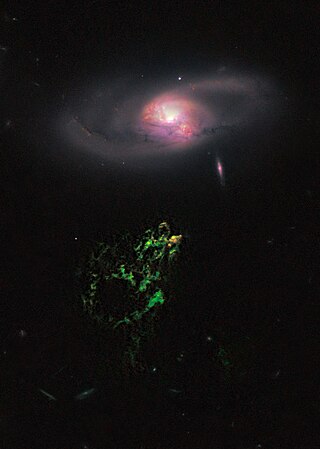
Messier 87 is a supergiant elliptical galaxy in the constellation Virgo that contains several trillion stars. One of the largest and most massive galaxies in the local universe, it has a large population of globular clusters—about 15,000 compared with the 150–200 orbiting the Milky Way—and a jet of energetic plasma that originates at the core and extends at least 1,500 parsecs, traveling at a relativistic speed. It is one of the brightest radio sources in the sky and a popular target for both amateur and professional astronomers.

A starburst galaxy is one undergoing an exceptionally high rate of star formation, as compared to the long-term average rate of star formation in the galaxy, or the star formation rate observed in most other galaxies.

A barred spiral galaxy is a spiral galaxy with a central bar-shaped structure composed of stars. Bars are found in about two thirds of all spiral galaxies in the local universe, and generally affect both the motions of stars and interstellar gas within spiral galaxies and can affect spiral arms as well. The Milky Way Galaxy, where the Solar System is located, is classified as a barred spiral galaxy.

The Sculptor Galaxy is an intermediate spiral galaxy in the constellation Sculptor. The Sculptor Galaxy is a starburst galaxy, which means that it is currently undergoing a period of intense star formation.
Luminous infrared galaxies or LIRGs are galaxies with luminosities, the measurement of brightness, above 1011 L☉. They are also referred to as submillimeter galaxies (SMGs) through their normal method of detection. LIRGs are more abundant than starburst galaxies, Seyfert galaxies and quasi-stellar objects at comparable luminosity. Infrared galaxies emit more energy in the infrared than at all other wavelengths combined. A LIRG's luminosity is 100 billion times that of the Sun.
A super star cluster (SSC) is a very massive young open cluster that is thought to be the precursor of a globular cluster. These clusters called "super" because they are relatively more luminous and contain more mass than other young star clusters. The SSC, however, does not have to physically be larger than other clusters of lower mass and luminosity. They typically contain a very large number of young, massive stars that ionize a surrounding HII region or a so-called "Ultra dense HII region (UDHII)" in the Milky Way Galaxy or in other galaxies. An SSC's HII region is in turn surrounded by a cocoon of dust. In many cases, the stars and the HII regions will be invisible to observations in certain wavelengths of light, such as the visible spectrum, due to high levels of extinction. As a result, the youngest SSCs are best observed and photographed in radio and infrared. SSCs, such as Westerlund 1 (Wd1), have been found in the Milky Way Galaxy. However, most have been observed in farther regions of the universe. In the galaxy M82 alone, 197 young SSCs have been observed and identified using the Hubble Space Telescope.

NGC 1808 is a barred spiral galaxy located in the southern constellation of Columba, about two degrees to the south and east of Gamma Caeli. It was discovered by Scottish astronomer James Dunlop, who described it as a "faint nebula". The galaxy is a member of the NGC 1808 group, which is part of the larger Dorado Group.

NGC 4323 is a lenticular or dwarf elliptical galaxy located about 52.5 million light-years away in the constellation Coma Berenices. The galaxy was discovered in 1882 by astronomer Wilhelm Tempel and is a member of the Virgo Cluster.

Hanny's Voorwerp is a type of astronomical object called a quasar ionization echo. It was discovered in 2007 by Dutch schoolteacher Hanny van Arkel while she was participating as a volunteer in the Galaxy Zoo project, part of the Zooniverse group of citizen science websites. Photographically, it appears as a bright blob close to spiral galaxy IC 2497 in the constellation Leo Minor.
SPT-CLJ2106-5844 is a galaxy cluster located 7.5 billion light years from Earth. It was discovered by scientists from the South Pole Telescope Collaboration, using the South Pole Telescope. With a weight of about 1.27 × 1015 solar masses, it is the most massive distant object known, as of 2011. It is about 60% heavier than previously known object detected in 2008, SPT-CL J0546-5345.

Swift J164449.3+573451, initially referred to as GRB 110328A, and sometimes abbreviated to Sw J1644+57, was a tidal disruption event (TDE), the destruction of a star by a supermassive black hole. It was first detected by the Swift Gamma-Ray Burst Mission on March 28, 2011. The event occurred in the center of a small galaxy in the Draco constellation, about 3.8 billion light-years away. It was the first confirmed jetted tidal disruption event and is the most luminous and energetic TDE recorded.
Bruce Gordon Elmegreen is an American astronomer.

Debra Meloy Elmegreen is an American astronomer. She was the first woman to graduate from Princeton University with a degree in astrophysics, and she was the first female post-doctoral researcher at the Carnegie Observatories.

NGC 541 is a lenticular galaxy located in the constellation Cetus. It is located at a distance of about 230 million light years from Earth, which, given its apparent dimensions, means that NGC 541 is about 130,000 light years across. It was discovered by Heinrich d'Arrest on October 30, 1864. It is a member of the Abell 194 galaxy cluster and is included in the Atlas of Peculiar Galaxies in the category galaxies with nearby fragments. NGC 541 is a radio galaxy of Fanaroff–Riley class I, also known as 3C 40A.

NGC 4294 is a barred spiral galaxy with flocculent spiral arms located about 55 million light-years away in the constellation Virgo. The galaxy was discovered by astronomer William Herschel on March 15, 1784 and is a member of the Virgo Cluster.

NGC 4299 is a featureless spiral galaxy located about 55 million light-years away in the constellation Virgo. It was discovered by astronomer William Herschel on March 15, 1784 and is a member of the Virgo Cluster.
Deidre A. Hunter is an American astronomer at Lowell Observatory. Her primary research area is tiny irregular galaxies — their origins, evolution and star-formation properties. She uses many parts of the electromagnetic spectrum, and includes spectroscopy in her approach.
Marc Alexander Rafelski is an American astrophysicist. Rafelski studied astronomy at the University of California, Los Angeles with Andrea Gehz. He obtained his PhD in physics from the University of California, San Diego, under supervision of Arthur Wolfe, in 2011.

NGC 4393 is a spiral galaxy about 46 million light-years away in the constellation Coma Berenices. It was discovered by astronomer William Herschel on April 11, 1785. It is a member of the NGC 4274 Group, which is part of the Coma I Group or Cloud.














